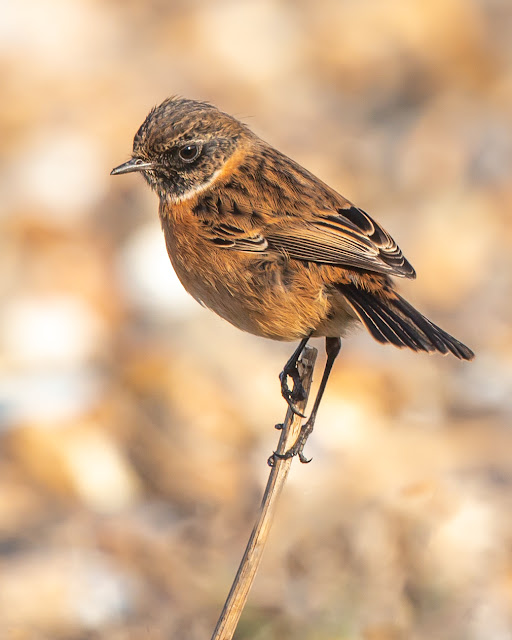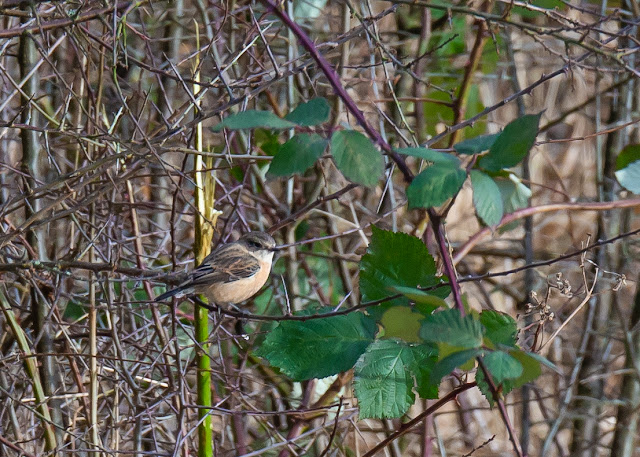 |
| Western Siberian Stonechat |
There are three species of stonechat on the BOU british list, the common european stonechat plus its two much rarer cousins, the Siberian and Stejneger's stonechats. The Siberian species is further split into two sub species, western and eastern. Stejneger's stonechat breeds in eastern Asia and migrates to southern China in winter. The Siberian stonechat breeds in most of temperate Asia and the far north west of Europe. It winters in southern Japan, Thailand, India and northeast Africa.
 |
| Stejneger's Stonechat |
Identification of the two Asia species is very tricky in the field and formal identification normally requires a DNA sample. These can be obtained from intestinal cells in the birds poo. The DNA analysis normally takes four to eight weeks hence the bird has normally moved on before formal identification can be confirmed.
I was lucky enough to see a Stejneger’s stonechat a few years ago in Norfolk but I still needed Siberian to give me the full set of the stonechats on the British list.
 |
| Eurasian Stonechat |
A suspected Siberian stonechat has been frequenting a nature reserve in Cheshire since Christmas and, unusually as per the above, the DNA analysis has come in while it was still on site confirming it to be a western Siberian stonechat.
Having narrowly survived a horrendous dose of man flu over last weekend, and with various other commitments, the first day I could go this week was Thursday. As is my habit, the alarm was duly set for silly o clock and I set off towards Cheshire in the pitch dark. An uneventful drive, only interrupted by a coffee stop, had me on site just after sunrise and apart from a few early dog walkers there was no one else around. I have an app on my phone called OS locate which is brilliant for getting you to the right spot on a twitch. My bird alert service, RBA, usually gives a precise map reference for the location which OS locate then easily navigates me to.
The reported location was next to a lake and wetland area and looked prime stonechat habitat. Scattered small bare shrubs looked perfect for the stonechat‘s normal modus operandi of perching up on a bush then dropping down on an unsuspecting insect. After five minutes or so I located the bird behaving exactly as described. It is a first winter male, noticeably very pale and hence quite difficult to pick up even on the bare shrubs. It was comparatively distant so I rattled off a few record shots and then settled down to watch the bird through my bins and scope. After 20 minutes or so another birder arrived and I was able to put him on the bird. I thought it was time for a quick check of my record shots and, horror of horror, my camera gleefully told me that there was no memory card installed! Being a total idiot I have neglected to replace them when the camera came back from repair. To compound the issue I normally keep a spare in the car just in case but I had taken it out a few days ago to check it!!
To cut a long story short, the next two hours were spent trying to locate and buy a suitable memory card locally and I ended up having to drive into Chester to buy one from a camera shop. After a quick sandwich lunch I arrived back on site to find five or so birders now present looking for the bird. Unusually, it was me who found the bird again almost immediately and I spent the next hour getting a few quite distant shots and watching and enjoying the bird.
 |
| Western Siberian Stonechat |
A work party of volunteers then arrived and announced that they were going to be working in exactly the spot the bird was in! A chap on a large lawn mower promptly started cutting down all the small shrubs the bird was perching it. It was somewhat fearlessly moving from one bush to another as its prime feeding habitat rapidly disappeared! I guess I was rather lucky to choose to go on Thursday as I suspect the lack of habitat will cause the bird to move on. I asked the chap who appeared to be in change why they were clearing the scrub and he quite reasonably explained that the area was being managed for invertebrates and that various rare insects and specialist plants they were depend on grew on the very alkaline soil. Hence the scrub needed to be removed every year. Interesting the site was an old lime quarry, hence the alkalinity of the soil, making it a unique local habitat.
I finished the day with a quick walk around the very pleasant reserve in the late afternoon sun and then departed to do battle with the twenty miles or so of road works on the M6. They are upgrading a stretch to “intelligent" motorways meaning the hard shoulder is replaced by an extra lane with variable speed limits. There are protected emergency laybys ever so often in case of breakdown. I recently read that the first experiments of this type worked well, i.e improved traffic flow, and had the emergency laybys every few hundred yards but to save money they can now be as much as several miles apart. Guess what – they have now discovered that the intelligent motorways are much less safe because people are breaking down with nowhere safe to go and other drives are crashing into them – no s**t sherlock!!!
Wow - narrow escape from photographic disaster!!! You would've thought they could have left the 'management' until it's left! I suppose it's been there long enough that they may have been leaving it, but surely it won't stay much longer. Just seems like madness. The fact that they're still installing 'Smart motorways' just IS madness - they've been proved to be dangerous & of limited value. Reminds me of the badger cull - even tho it's been proved ineffective they press on with that for the rich landowners who don't want badgers. Presumably they press on with 'smart motorways' for their rich mates who are the bosses/shareholders of the companies that have the contract(s).... Anyway, enough politics!!! x
ReplyDelete